
(a)
Interpretation:
A mechanism for the initiation step for the
Concept introduction:
The
The polymerizations can be initiated by anions or cations, resulting in anionic polymerization or cationic polymerization, respectively. The polymerization involves, 1) initiation, 2) propagation, and 3) termination.
Initiation is the first step of the polymerization process. An active center is created during initiation, from which a polymer chain is generated. Not all monomers are susceptible to all types of initiators.
In propogation a reactive intermediate is repetitively redeveloped throughout the sequence of a chemical chain reaction. Then it is terminated by adding mono
Answer to Problem 26.42P
The initiation step for the polymerization reaction of the given compound is as follows.
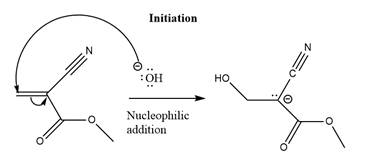
Explanation of Solution
The
The given explanation is obtained by applying the concept polymerization mechanism.
(b)
Interpretation:
A mechanism for the propagation step for the polymerization reaction of the given compound is to be determined.
Concept introduction:
The chemical reaction in which the monomer molecules reacts together to form polymer chains or three dimentional networks is termed as polymerization. This are classified by different syatem avaible for the different types if polymerization.
The polymerizations can be initiated by anions or cations, resulting in anionic polymerization or cationic polymerization, respectively. The polymerization involves, 1) initiation, 2) propagation, and 3) termination.
Initiation is the first step of the polymerization process. An active center is created during initiation, from which a polymer chain is generated. Not all monomers are susceptible to all types of initiators.
In propogation a reactive intermediate is repetitively redeveloped throughout the sequence of a chemical chain reaction. Then it is terminated by adding mono functional groups that having equal of different types of monomer.
Answer to Problem 26.42P
The propagation step for the polymerization reaction of the given compound is as follows.
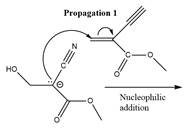
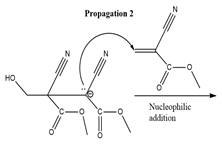
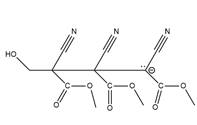
Explanation of Solution
The carbanion formed in initiation step reacts with another equivalent of
in the first nucleophilic addition step. The propagation step repeats the nucleophilic addition reaction.
The given explanation is obtained by applying the concept polymerization mechanism.
(c)
Interpretation:
The structure of
Concept introduction:
The chemical reaction in which the monomer molecules reacts together to form polymer chains or three dimentional networks is termed as polymerization. This are classified by different syatem avaible for the different types if polymerization.
The polymerizations can be initiated by anions or cations, resulting in anionic polymerization or cationic polymerization, respectively. The polymerization involves, 1) initiation, 2) propagation, and 3) termination.
Initiation is the first step of the polymerization process. An active center is created during initiation, from which a polymer chain is generated. Not all monomers are susceptible to all types of initiators.
In propogation a reactive intermediate is repetitively redeveloped throughout the sequence of a chemical chain reaction. Then it is terminated by adding mono functional groups that having equal of different types of monomer.
Answer to Problem 26.42P
The structure of
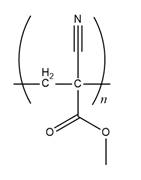
Explanation of Solution
The propagation step repeats the nucleophilic addition reaction to produce
The given explanation is obtained by applying the concept polymerization mechanism.
(d)
Interpretation:
Why is
Concept introduction:
The chemical reaction in which the monomer molecules reacts together to form polymer chains or three dimentional networks is termed as polymerization. This are classified by different syatem avaible for the different types if polymerization.
The polymerizations can be initiated by anions or cations, resulting in anionic polymerization or cationic polymerization, respectively. The polymerization involves, 1) initiation, 2) propagation, and 3) termination.
Initiation is the first step of the polymerization process. An active center is created during initiation, from which a polymer chain is generated. Not all monomers are susceptible to all types of initiators.
In propogation a reactive intermediate is repetitively redeveloped throughout the sequence of a chemical chain reaction. Then it is terminated by adding mono functional groups that having equal of different types of monomer.
Answer to Problem 26.42P

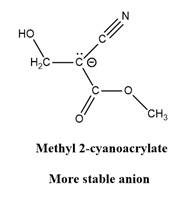
Explanation of Solution
The given explanation is obtained by applying the concept polymerization mechanism, resonance and inductive effect.
(e)
Interpretation:
Why or why not methyl 2-cyanoacrylate would be a good candidate for cationic polymerization is to be explained.
Concept introduction:
The chemical reaction in which the monomer molecules reacts together to form polymer chains or three dimentional networks is termed as polymerization. This are classified by different syatem avaible for the different types if polymerization.
The polymerizations can be initiated by anions or cations, resulting in anionic polymerization or cationic polymerization, respectively. The polymerization involves, 1) initiation, 2) propagation, and 3) termination.
Initiation is the first step of the polymerization process. An active center is created during initiation, from which a polymer chain is generated. Not all monomers are susceptible to all types of initiators.
In propogation a reactive intermediate is repetitively redeveloped throughout the sequence of a chemical chain reaction. Then it is terminated by adding mono functional groups that having equal of different types of monomer.
Answer to Problem 26.42P
Explanation of Solution
The given explanation is obtained by applying the concept polymerization mechanism.
Want to see more full solutions like this?
Chapter 26 Solutions
ORGANIC CHEMISTRY E-BOOK W/SMARTWORK5
 ChemistryChemistryISBN:9781305957404Author:Steven S. Zumdahl, Susan A. Zumdahl, Donald J. DeCostePublisher:Cengage Learning
ChemistryChemistryISBN:9781305957404Author:Steven S. Zumdahl, Susan A. Zumdahl, Donald J. DeCostePublisher:Cengage Learning ChemistryChemistryISBN:9781259911156Author:Raymond Chang Dr., Jason Overby ProfessorPublisher:McGraw-Hill Education
ChemistryChemistryISBN:9781259911156Author:Raymond Chang Dr., Jason Overby ProfessorPublisher:McGraw-Hill Education Principles of Instrumental AnalysisChemistryISBN:9781305577213Author:Douglas A. Skoog, F. James Holler, Stanley R. CrouchPublisher:Cengage Learning
Principles of Instrumental AnalysisChemistryISBN:9781305577213Author:Douglas A. Skoog, F. James Holler, Stanley R. CrouchPublisher:Cengage Learning Organic ChemistryChemistryISBN:9780078021558Author:Janice Gorzynski Smith Dr.Publisher:McGraw-Hill Education
Organic ChemistryChemistryISBN:9780078021558Author:Janice Gorzynski Smith Dr.Publisher:McGraw-Hill Education Chemistry: Principles and ReactionsChemistryISBN:9781305079373Author:William L. Masterton, Cecile N. HurleyPublisher:Cengage Learning
Chemistry: Principles and ReactionsChemistryISBN:9781305079373Author:William L. Masterton, Cecile N. HurleyPublisher:Cengage Learning Elementary Principles of Chemical Processes, Bind...ChemistryISBN:9781118431221Author:Richard M. Felder, Ronald W. Rousseau, Lisa G. BullardPublisher:WILEY
Elementary Principles of Chemical Processes, Bind...ChemistryISBN:9781118431221Author:Richard M. Felder, Ronald W. Rousseau, Lisa G. BullardPublisher:WILEY





